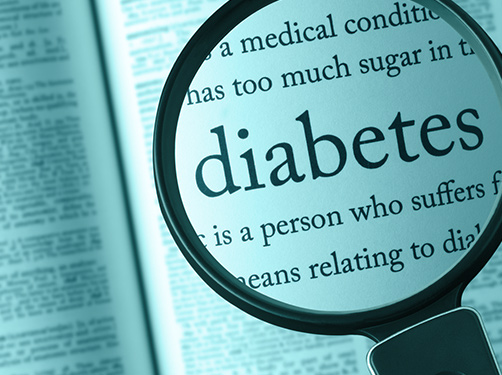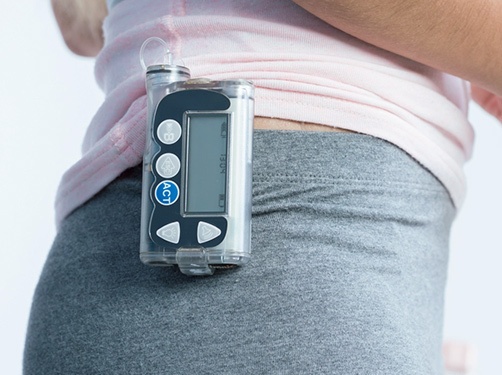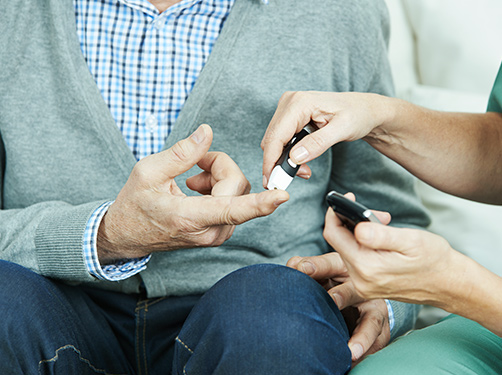Acting correctly in a diabetes emergency
Scientific support: Andreas Vosseler M.A.
There are 2 emergency situations in diabetes: Low blood sugar, also called hypoglycemia, and high blood sugar, also called hyperglycemia. In most cases, people with diabetes can help themselves if they have very low or very high blood sugar levels. Nevertheless, both low and high blood sugar levels (diabetic ketoacidosis or hyperosmolar hyperglycemic syndrome) can lead to unconsciousness and can be life-threatening.
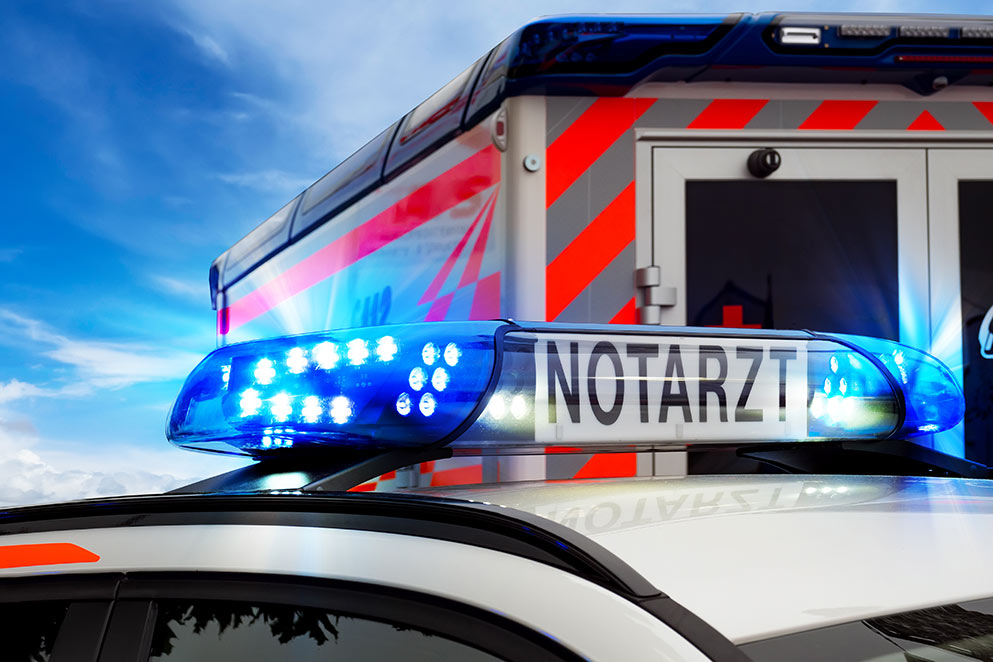
Follow these steps if a person with diabetes is unable to help themselves in an emergency:
Step 1: Is the person unconscious?
If the person is unconscious, call the emergency service (112 or 116 117) immediately. Under no circumstances should anything be poured into someone’s mouth if that person is unconscious. Such persons are at risk of choking.
If you are not sure whether it is hyperglycemia or hypoglycemia: Do not use glucagon injection or nasal spray and do not inject insulin.
Step 2: Is it hypoglycemia or hyperglycemia?
It is important to find out if the person with diabetes has a low or a high blood sugar level. When inappropriate action is taken, the emergency situation may otherwise deteriorate.
Ask the person for his or her current blood sugar level. If he or she is not sure, ask him or her to measure the blood sugar.
If necessary, you can also read the value on an insulin pump, smartphone, or smartphone-like reader. If a blood sugar measurement device is at hand and you know how to use it, you can also take blood from the finger pulp for the measurement. Find out more about blood sugar measurement here.
Read the blood sugar: Is it a high or a low value?
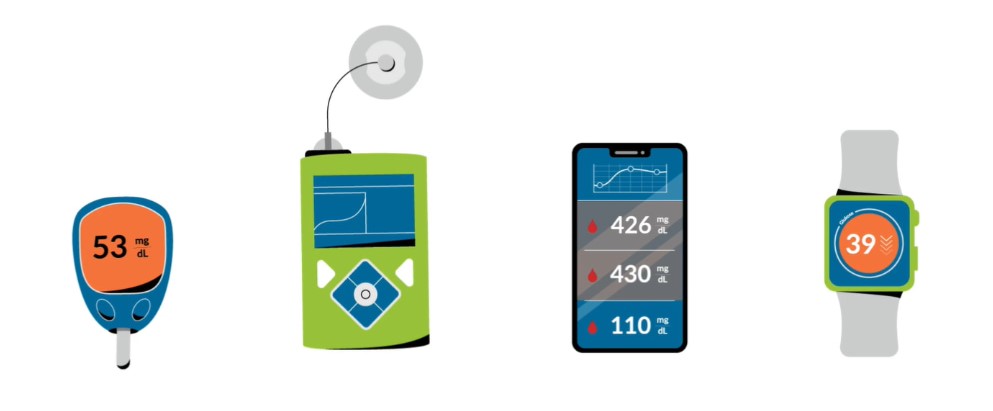
Hypoglycemia | Hyperglycemia |
Severe hypoglycemia can occur at blood sugar levels below 70 mg/dl (3.9 mmol/l)*. If the blood sugar drops below a certain level, the measuring device may display “LOW”. The limit at which blood sugar levels become noticeable varies from individual to individual.
Typical symptoms of low blood sugar levels are:
| |
Severe hyperglycemia can occur at blood sugar levels of 250 mg/dl (13.9 mmol/l) and above. Values above 1,000 mg/dl (55.5 mmol/l) are also possible. Some blood sugar measurement devices are not able to show severely elevated values. In this case, the display shows “HI”.
Typical symptoms of high blood sugar levels are:
Sweet smelling breath may be a sign of a particularly dangerous diabetic ketoacidosis. |
*According to the American Diabetes Association (ADA) definition, low blood sugar levels are indicated by values below 70 mg/dl (3.9 mmol/l).
Immediate measures in the event of a low blood sugar level (hypoglycemia)
In the event of a low blood sugar level, follow these steps:
- If the person is unconscious, call emergency services.
- If the person is unable to swallow, do not pour anything into his or her mouth. Such persons are at risk of choking. Call the emergency medical services immediately.
- If the person is responsive, give them something containing sugar to drink or eat, for example, a sugar-containing drink such as fruit juice or lemonade (note: no light or zero drinks). Dextrose tablets or other sugar-containing foods such as honey or gummy bears are also suitable. Foods with a high fat content, e.g., chocolate are less suitable because they raise blood sugar relatively slowly.
- If available, use a glucagon injection or glucagon nasal spray. Instructions for use can be found here, on the package insert and on the packaging.
- Do not leave the person alone. Help him or her into a safe position.
- Measure blood sugar again after 15 minutes and assess the health status.
First aid protocol for low blood sugar levels (hypoglycemia)
Immediate measures in the event of high blood sugar levels (hyperglycemia)
In the event of a high blood sugar level, follow these steps:
- In case of drowsiness or unconsciousness, call 911.
- If the person is responsive, ask him or her to directly treat the hyperglycemia. An emergency plan has usually been established in advance with the diabetes specialist.
- Perform a test for ketones, if possible.
- It is important that the person affected drinks plenty of water.
- Do not leave the person alone. Help him or her into a safe position.
- Check the blood sugar level as well as the health status regularly.
First aid protocol for high blood sugar levels (hyperglycemia)
Good to know:
Sweet-smelling breath and labored breathing, fatigue, and vomiting may be signs of a diabetic ketoacidosis, which is most common in type 1 diabetes. This is a very dangerous and life-threatening emergency situation.
Even in type 2 diabetes, severe hyperglycemia can lead to unconsciousness and can be life-threatening. Signs of such an emergency situation may include, for example, severe fatigue, nausea, dizziness, visual disturbances, increased thirst and frequent urination. This is also referred to as hyperosmolar hyperglycemic syndrome.
Video: Acting correctly in a diabetes emergency
This video is available with English subtitles.
More information on hypoglycemia and hyperglycemia in diabetes
Sources:
Bundesärztekammer et al.: Nationale Versorgungsleitlinie Therapie des Typ-2-Diabetes. Langfassung. 1. Auflage. Version 4. 2014 (Gültigkeit abgelaufen, in Überarbeitung)
Bundesärztekammer et al.: Nationale Versorgungsleitlinie Typ-2-Diabetes. Teilpublikation der Langfassung. 2. Auflage. Version 1. 2021
Deutsche Diabetes Gesellschaft: S3-Leitlinie Therapie des Typ-1-Diabetes. 2. Auflage. 2018
Haak, T. et al.: DDG-Praxisempfehlungen: Therapie des Typ-1-Diabetes. 2. Auflage. 2022
As of: 04.04.2023

